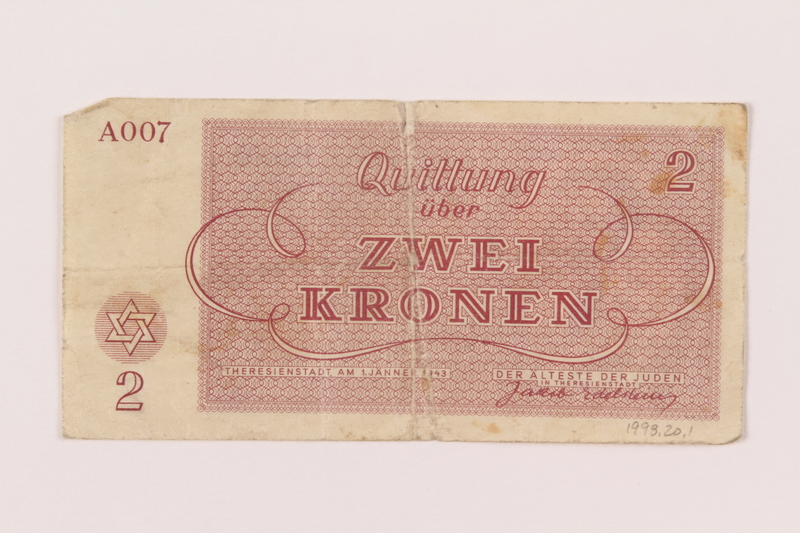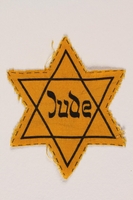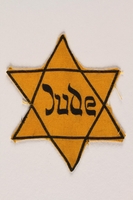Overview
- Brief Narrative
- Scrip, valued at 2 (zwei) kronen, distributed in Theresienstadt (Terezin) ghetto-labor camp beginning in May 1943. The ghetto currency was printed by the National Bank in 7 similar, beautifully designed denominations: 1, 2, 5, 10, 20, 50, 100. Currency was confiscated from inmates and replaced with scrip for exchange only in the camp. There was little to obtain in exchange for the scrip, except library books. Located thirty miles northwest of Prague in German occupied Czechoslovakia, the ghetto-labor camp was established by the Germans in November 24, 1941, and ceased operation in early May 1945. In 3.5 years, approximately 140,000 Jewish persons were transferred to Terezin; nearly 90,000 were then deported, likely to their death, further east. About 33,000 died in Theresienstadt.
- Date
-
issue:
1943 January 01
- Geography
-
issue:
Theresienstadt (Concentration camp);
Terezin (Ustecky kraj, Czech Republic)
- Credit Line
- United States Holocaust Memorial Museum Collection, Gift of Denise Kopecky
- Markings
- face, center, red ink : QUITTUNG ÜBER / ZWEI KRONEN / 2 / WER DIESE QUITTUNG VERFÄLSCHT ODER NACHMACHT / ODER GEFÄLSCHTE QUITTUNGEN IN VERKEHR BRINGT. / WIRD STRENGSTENS BESTRAFT [Receipt / of / TWO CROWNS / ANYONE WHO FALSIFIES OR DISTORTS OR FAKES THIS RECEIPT, OR COUNTERFEITS RECEIPT, WILL BE STRICTLY PUNISHED]
face, lower right corner, red ink : 2
reverse, upper left corner, plate mark, red ink : A007
reverse, upper right corner, red ink : 2
reverse, lower left corner, red ink : 2
reverse, center, red ink : Quittung / über / ZWEI KRONEN / THERESIENSTADT, AM 1.JANNER 1943 DER ALTESTE DER JUDEN / IN THERESIENSTADT / Jakob Edelstein [Receipt / of / TWO CROWNS / THERESIENSTADT, ON 1. JANUARY 1943 THE ELDER OF THE JEWS IN THERESIENSTADT / Jakob Edelstein] - Contributor
-
Subject:
Denise E. Kopecky
Printer: National Bank of Prague
Designer: Peter Kien
Issuer: Der Alteste der Juden in Theresienstadt
- Biography
-
Denise Kopecky (born Denise Elbert or Elbertsova) was born on August 22, 1941 in Nemecka Lupca, Slovakia to Hugo and Alice (Winczer) Elbert. Hugo owned a wholesale business before the war and her mother had taught piano. In March 1939, Nemecka Lupca became part of the newly independent state of Slovakia, whose fascist government moved quickly to impose restrictions on its Jewish population. These measures were intensified in the summer of 1941 when Slovak troops entered the war as allies of the German Reich. Deportations of Slovak Jews to ghettos and camps in Poland began in March 1942 and continued through October. After having their business Aryanized and their personal property confiscated, Denise's parents and Uncle Alexander Elbert were deported to the Lublin district in June 1942. She was left behind with her grandparents, Gejza and Melania Elbert. Her grandfather, however, died suddenly the following month. Denise, who was then less than a year old, was saved from deportation by Maria Bela, a Christian friend of her parents, who had secured a new birth and baptismal certificate for her from a local Lutheran minister in May 1942. After the death of her husband, Melania fled with Denise to the mountains, where they remained for several months. In 1943 they returned to Nemecka Lupca after receiving assurances from the Slovak woman who had taken over Hugo's business, that it was safe to do so. A short time later, however, they were sent to Theresienstadt, where they remained until their liberation by the Soviets in May 1945. Denise was only three years old when the war ended. Following their release, Melania and Denise returned to Nemecka Lupca. Denise later married Richard Kohn, a fellow survivor from Slovakia who had been interned as a young boy in the Novaky labor camp.
Franz Peter Kien was born January 1, 1919, in Varnsdorf, Czechoslovakia (Czech Republic), to Leonard and Olga Frankl Kien. His father Leonard was born in 1886, in Varnsdorf, and was a member of the German-speaking Jewish population in the, the Sudetenalnd, which bordered Germany. Leonard was a textile manufacturer with his own factory. Peter’s mother Olga was born in 1898, in Bzenec, Austro-Hungary (Czech Republic), to Jewish parents. After 1929, the Kien family moved to Brno. Peter enrolled at the German Gymnasium, where he excelled at drawing, painting, and writing. In 1936, he graduated and moved to Prague to study at the Academy of Fine Arts. He also attended the Officina Pragensis, a private graphic design school run by a well-known Jewish artist, Hugo Steiner-Prag.
On September 29, 1938, Germany annexed the Sudetenland. On March 15, 1939, Germany invaded Prague and annexed the Bohemia and Moravia provinces of Czechoslovakia, ruled by a Reich Protector. Jews were banned from participation in government, businesses, and organization, including schools. Peter had to leave the Academy, but continued to study at the Officina Pragensis. He also taught at Vinohrady Synagogue. In September 1940, Peter married Ilse Stranska, who was born on May 9, 1915, in Pilsen, to Jewish parents.
In late September 1941, Reinhard Heydrich, the SS head of RSHA, Reich Main Security Office, became Reich Protector. Soon there were regular deportations of Jews to concentration camps. At the end of November, Theresienstadt concentration and transit camp near Prague got its first shipment of Jewish prisoners. On December 14, Peter was transported to Theresienstadt ghetto-labor camp. He was assigned to the technical department where he worked as a draftsman and designer alongside other artists, including Bedrich Fritta, Leo Haas, and Jiri Lauscher. On July 16, 1942, Peter’s wife Ilse arrived in the camp. On January 30, 1943, Peter’s parents Leonard and Olga were transported from Bzenec to Terezin. Peter was assigned major projects by the Jewish Council that administered the camp for the Germans, such as the scrip receipts used in place of money in the camp. He secretly documented the inmate’s daily life, creating portraits and other drawings, and wrote plays, poems, and an operatic libretto. On October 16, 1944, Peter’s wife Ilse and his parents Leonard and Olga were selected for deportation. Peter volunteered to go with them. Before leaving, Peter and his family were sent to Auschwitz concentration camp in German-occupied Poland. Peter survived the selection process, soon fell ill, likely with typhus, and died at age 25 in late October 1944. His wife and parents were killed at Auschwitz. Some of the work that Peter left with other prisoners or hid at Theresienstadt survived and has been exhibited worldwide.
Physical Details
- Classification
-
Exchange Media
- Category
-
Money
- Object Type
-
Scrip (aat)
- Physical Description
- Theresienstadt scrip printed on rectangular, offwhite paper in red/brown and light red ink. The face has a vignette with an image of Moses, a bearded man with a wrinkled brow, holding 2 stone tablets with the 10 Commandments in Hebrew. To the right is the denomination 2 and German text. The background rectangle has a geometric latticework pattern. On the right is a wide, offwhite border with 2 in the bottom corner below a Star of David. The reverse has a background rectangle with an interlocked diamond pattern, overprinted with German text, an engraved signature, and a scrollwork line. The denomination 2 is in the upper right corner. On the left is a wide, off-white border with 2 in the lower corner below a Star of David in a lined circle. The plate letter and number are in the upper left corner. Scrip is stained, creased, and very worn.
- Dimensions
- overall: Height: 2.125 inches (5.398 cm) | Width: 4.375 inches (11.113 cm)
- Materials
- overall : paper, ink
Rights & Restrictions
- Conditions on Access
- No restrictions on access
- Conditions on Use
- No restrictions on use
Keywords & Subjects
Administrative Notes
- Legal Status
- Permanent Collection
- Provenance
- The scrip was donated to the United States Holocaust Memorial Museum in 1998 by Denise Kopecky.
- Funding Note
- The cataloging of this artifact has been supported by a grant from the Conference on Jewish Material Claims Against Germany.
- Record last modified:
- 2022-07-28 18:23:35
- This page:
- https://collections.ushmm.org/search/catalog/irn12707
Download & Licensing
In-Person Research
- By Appointment
- Request 21 Days in Advance of Visit
- Plan a Research Visit
- Request to See This Object
Contact Us
Also in Denise Kopecky collection
The collection consists of three Theresienstadt notes and two Star of David badges relating to the experiences of Denise Elbertova while living in hiding in the Slovak Republic and, after 1944, in Theresienstadt ghetto-labor camp during the Holocaust.
Date: 1944-1945
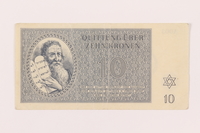
Theresienstadt ghetto-labor camp scrip, 10 kronen note, owned by a child inmate
Object
Scrip, valued at 10 (zehn) kronen, distributed in Theresienstadt (Terezin) ghetto-labor camp beginning in May 1943. The ghetto currency was printed by the National Bank in 7 similar, beautifully designed denominations: 1, 2, 5, 10, 20, 50, 100. Currency was confiscated from inmates and replaced with scrip for exchange only in the camp. There was little to obtain in exchange for the scrip, except library books. Located thirty miles northwest of Prague in German occupied Czechoslovakia, the ghetto-labor camp was established by the Germans in November 24, 1941, and ceased operation in early May 1945. In 3.5 years, approximately 140,000 Jewish persons were transferred to Terezin; nearly 90,000 were then deported, likely to their death, further east. About 33,000 died in Theresienstadt.
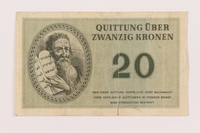
Theresienstadt ghetto-labor camp scrip, 20 kronen note, owned by a child inmate
Object
Scrip, valued at 20 (zwanzig) kronen, distributed in Theresienstadt (Terezin) ghetto-labor camp beginning in May 1943. The ghetto currency was printed by the National Bank in 7 similar, beautifully designed denominations: 1, 2, 5, 10, 20, 50, 100. Currency was confiscated from inmates and replaced with scrip for exchange only in the camp. There was little to obtain in exchange for the scrip, except library books. Located thirty miles northwest of Prague in German occupied Czechoslovakia, the ghetto-labor camp was established by the Germans in November 24, 1941, and ceased operation in early May 1945. In 3.5 years, approximately 140,000 Jewish persons were transferred to Terezin; nearly 90,000 were then deported, likely to their death, further east. About 33,000 died in Theresienstadt.


